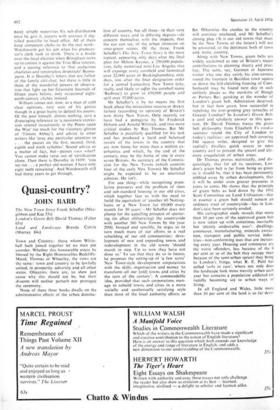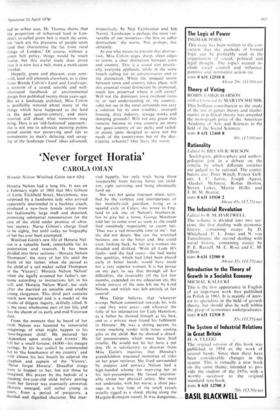Quasi-country?
JOHN b'ARR
The New Town Story Frank Schaffer (Mac- gibbon and Kee 55s) London's Green Belt David Thomas (Faber 65s) Land and Landscape Brenda Colvin (Murray 84s)
Town and Country: those whom White- hall hath joined together let no man put asunder. Whether this honourable estate be blessed by the Right Honourables Redcliffe- Maud, Thomas or Wheatley, the vows are the same: town and country to be lawfully united, in prosperity, adversity and all other states. Objectors there are, to shew just cause why this should not be, but their dissents will neither perturb nor prorogue the ceremony.
None of these three books dwells on the administrative effects of the urban domina- tion of country, but all three—in their very different ways, and in differing degrees—do concern themselves with the impacts, that the eye can see, of the urban intrusion on once-green scenes. Of the three, Frank Schaffer's The New Town Story is the most topical, appearing only days after the final plan for Milton Keynes, a 250,000-popula- tion, fully motorised mini-Los Angeles that will expunge every cornfield and farmstead over 22,000 acres of Buckinghamshire; only days, too, after the final designation order for a central Lancashire New Town (city, really, and likely to suj'fer the cornball name 'Redrose') to grow to 430,000 people and spill over 35,000 acres.
Mr Schaffer's is by no means the first book about the miraculous success or dreary failure (according to opinion) of Britain's now thirty New Towns. Only recently we have had a panegyric by Sir Frederick Osborn and Arnold Whittick, and two more critical studies by Ray Thomas. But Mr Schaffer is peculiarly qualified for his task and has produced a lucid and balanced review of the towns in the country that are now home for more than a million ex- urbanites and which, by the end of the century, may be the home of one in every seven Britons. As secretary of the Commis- sion for the New Towns (which controls four of the early New Towns) Mr Schaffer might be expected to be an uncritical admirer. He isn't.
For one thing—while recognising popu- lation pressures and the problem of slum and sub-standard housing in our old cities, which together face us with the need to build the equivalent of 'another 60 Notting- hams or a New Town for 60,000 every month for 30 years'—Mr Schaffer does not plump for the appalling prospect of spatter- ing (in effect obliterating) the countryside with another 360 New Towns by the year 2000. Instead and sensibly, he urges us to turn much more of our efforts to a real rebuilding of our old communities: deve- lopment of new and expanding towns and redevelopment in the old towns 'should march in step. Up to now they have not done so.' To see that they do so in future, he proposes the setting-up of 'a few score' New Town-style development corporations with the skills, organisation and money `to transform all our [old) towns and cities by the turn of .the century'. A commendable idea, provided that such corporations man- age to rebuild towns and cities in a more socially and aesthetically satisfying style than most of the local authority efforts so far. Otherwise the exodus to the country will continue unabated, and Mr Schaffer's closing plea tit is our old towns that must be the New Towns of the future') will not be answered, to the detriment both of town and, more, country.
Along with New Towns, green belts are widely acclaimed as one of Britain's major contributions to planning theory and prac- tice. The same, say, German or Japanese visitor who one day swirls his cine-camera round the fountain in Basildon town square or down the hill-clutching housing of Cum- bernauld may be found next day in such unlikely places as the outskirts of Slough or Potters Bar, gawking at the wonder of London's green belt. Admiration deserved,
but in fact how green, how successful in repulsing the ever-groping grey tentacles of Greater London? In London's Green Belt, a cool and scholarly answer to this ques- tion, Dr David Thomas traces the green belt philosophy from Elizabeth I's cordon sanitaire round the City of London to
today's realities: an approved belt covering 846 square miles, designed to give the capital's dwellers quick access to open country and to prevent the sprawl and ulti- mate coagulation of urban areas.
Dr Thomas proves statistically, and dis- quietingly, that for all its successes, Lon- don's green belt is far from being as green as it should be, that it has been persistently nibbled away by urban developments, that it will be under even greater pressures in years to come. He shows that the principle of green belts as laid down by the 1942 Scott Committee on Land Utilisation—that in essence a green belt should remain an ordinary tract of countryside—has in Lon- don's case been seriously eroded.
His cartographic study reveals that more than 10 per cent of the approved green belt is now taken up with sometimes inevitable but 'plainly undesirable uses': dwellings, commerce, manufacturing, minerals extrac- tion, transport and public service indus- tries—non-conforming uses that are increas- ing every year. Housing and commerce are the worst offenders, less because of the 6 per cent or so of the belt they occupy than because of the semi-urban sprawl they bring to London's fringe, what R. E. Pahl has
called 'orbs in rure', where not only does the landscape look more messily urban each year but contains a population addicted (or rapidly becoming so) to urban ways of living.
In all England and Wales, little more than 10 per cent of the land is so far devo-
ted to urban uses. Dr Thomas shows that the proportion of urbanised land in Lon- don's so-called green belt is much the same, for 'such are the pressures of people upon land that characterise the far from rural fringe of London.' Of course, without a green belt policy, things would be much worse, but this useful study does prove that it is now less a belt, more a moth-eaten blanket.
Happily, green and pleasant, even semi- wild, land still abounds elsewhere, as is clear from Brenda Colvin's Land and Landscape, a revision of a sound, sensible and well- illustrated handbook of environmental design first published twenty-three years ago. But as a landscape architect, Miss Colvin is justifiably worried about many of the things which have happened to the land in the past quarter-century, and more worried still about what tomorrow may bring. Hers is an 'old-fashioned' approach: she is not one to advocate painting pylons proud scarlet nor preserving spoil tips as monuments to man's defacing and savag- ing of the landscape ('mod' ideas advanced, respectively, by Nan Fairbrother and Ian Nairn). 'Landscape is perhaps the most vul- nerable of our resources—the first to suffer destruction,' she warns. Not perhaps, but certainly.
As one who means to prevent that destruc- tion, Miss Colvin urges sharp, clean edges to towns, a clear distinction between town and country. This is a visual aim practic- ally everyone applauds, while in the same breath calling for an administrative end to the distinction. When the unequal union between town and country takes place, will this essential visual distinction be promoted, much less preserved where it still exists? Will not the dominant town (without roots in, or real understanding of, the country- side) not see in the rural surrounds too easy a solution for its own troubles: overspill housing, dirty industry, sewage works and dumping grounds? Will not any green that - remains become in time country no more but quasi-country of car parks and railed- in picnic spots designed to serve not the needs of the countryman but of the day- tripping urbanite? One fears the worst.







































 Previous page
Previous page